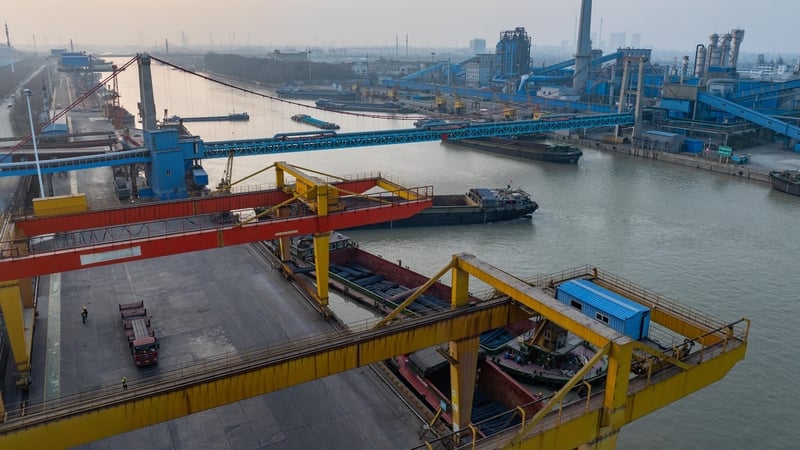As the smoke cleared from President Trump’s tariff-induced global economic explosion, one clear target emerged – China.
It is the world’s second biggest economy, America’s largest trading partner and the country Mr Trump has long accused of unfair trade practices.
World leaders were “kissing his ass” dying to do a deal, Mr Trump told the National Republican Congressional Committee President’s Dinner, hours before the tariffs kicked in.
One of those certainly not puckering up was China’s President, Xi Jinping.
China defiantly announced 84% tariffs on US goods and said it would “fight to the end”.
Piqued by China’s temerity, Mr Trump hiked levies even higher – to a whopping 145% – while everyone else got their 90-day reprieve.
Upping the ante, Mr Xi responded with 125% duties on US imports. The gloves were off, although Team Trump appeared to be dropping heavy hints that they were open to talks with Beijing.
“Pick up the phone, come to the table,” the White House’s top trade adviser Peter Navarro urged Mr Xi on Fox News.
But the phone didn’t ring.

“At some point, hopefully in the near future, China will realise that the days of ripping off the USA, and other countries, is no longer sustainable or acceptable,” President Trump wrote on his social media site Truth Social.
But will it?
Some analysts believe that Trumpism is unlikely to change China.
Why? Because the opposite has already happened.
“Instead of China coming to resemble the United States, the United States is behaving more like China,” wrote Michael Froman, former US trade representative, now President of the Council of Foreign Relations in New York, in Foreign Affairs.
“Washington may have forged the open, liberal rules-based order, but China has defined its next phase: protectionism, subsidisation, restrictions on foreign investment, and industrial policy,” he wrote.
For many years, the consensus in Washington – and, indeed, in Brussels – held that welcoming China into the global trading club would encourage economic liberalisation.
A prospering Chinese population would then demand – and be given – political freedoms, the argument went.
As we now know, that didn’t transpire.
Instead, China’s rising prosperity was accompanied by a tightening authoritarian grip on centralised power, the pursuit of statist economic policies, harnessing of nationalistic fervour and a brutal crackdown on dissent.
Read more:
US stocks sink amid escalating trade war with China
China hits back with tariffs on US goods after Trump imposes new levies
Any perceived challenge to Communist Party rule was brought to heel.
Protesters on the streets of Hong Kong, human rights defenders, Uyghurs, journalists, college campus Marxists, feminists, religious leaders as well as senior Communist Party officials insufficiently loyal to Xi Jinping were swept up.
But foreign investment poured in.
Mr Trump wasn’t the only world leader bemoaning China’s trade practices, though.
In fact, ever since China acceded to the World Trade Organization in 2001, other members complained that China’s state subsidies, cheap labour, alleged currency manipulation and forced transfer of technology as a condition for market entry were disadvantaging other nations’ industrial base.
China rejected accusations of unfair trade practices and pointed to its huge stimulus measures often credited with saving the global economy after the 2008 financial crash.
Still, a resentment simmered in some quarters that China had entered the playing field and proceeded to tilt it firmly in its own direction.
As recently as January, the European Commission lodged a complaint with the WTO alleging “unfair and illegal” trade practices over intellectual property rights.
For years before that, Europe and China had frequently fallen out over what the EU saw as a flood of cheaper Chinese products drowning its home-grown industry. Think shoes, toys and more recently, electric vehicles.
And, way back when Donald Trump was only famous for reality TV, previous occupants of the White House also railed against China’s rewiring of global trade to its own advantage.
The Obama administration launched multiple challenges at the WTO, decrying China’s system as “not transparent, predictable or fair”.

By the time Donald Trump came to power in 2016 and unleashed his first slew of tariffs on China, many American businesses operating there applauded his efforts to finally push through a correction.
As a reporter based then in Beijing, I recall conversations with business executives who were disgruntled about being forced into joint ventures and intellectual property shares with Chinese firms, whilst competing with Chinese state-backed domestic enterprise.
They hoped Mr Trump’s towering tariffs and tough talk would usher in long-awaited change.
It didn’t – partly because of the Covid-19 pandemic that broke out in Wuhan, China, in late 2019 ground international trade to a halt. But also, because China had already been preparing for global economic shocks of the variety Mr Trump could administer for some time.
“Beijing, and, in particular, Xi Jinping, probably feels extremely vindicated in their choices over the last decade or so,” said Jacob Gunter, lead analyst at MERICS, a Berlin-based think tank.
Mr Xi was the original “de-coupler,” he told RTÉ News, and aggressively pursued a policy of “self-reliance” to become less dependent on the US in every way.
“The language that they use for this is that China will enter a period of protracted struggle with the United States and its allies,” he said, “and now we are in the process of testing whether that preparation was sufficient or not”.
In the past few years, China has succeeded in diversifying its export markets away from the United States, boosting trade relations with countries in Europe and developing economies in the global south.
Since the first Trump administration, Chinese exports to the US dropped from around 20% to less than 13% of total exports.
In the name of self-reliance, Beijing also encouraged domestic consumption, albeit with limited success (Chinese consumers are traditionally savers, rather than spenders).
And, in 2015, Beijing announced a major state-financed industrial policy to achieve global pre-eminence in key manufacturing and technology sectors like artificial intelligence, robotics, green energy, high-speed rail and pharmaceuticals.

This “Made in China 2025” initiative delivered tangible results, experts concluded, and a few shocks to boot.
When China’s AI chatbot DeepSeek – deemed a cheaper and possibly better rival to US models – was unveiled earlier this year, it was met with a collective gasp in Silicon Valley and panic among investors.
It was a game-changer, many tech-bros believed.
American consumers altered shopping habits to favour Chinese low-cost e-commerce giants like Shein and Temu and lapped up recent innovations from China like TikTok.
President Xi is unlikely to ever have to contend with a potential revolt from his population over the ban of American social media – like Mr Trump does with TikTok – because US platforms such as Meta and X were never allowed to operate in China in the first place.
Beyond its borders, the “Made in China 2025” industrial policy certainly delivered on China’s bid to dominate key sectors.
China produces around 60% of the world’s electric vehicles, half of the world’s ships, 80% of commercial drones, nearly 90% of the world’s solar panels and between 70 and 90% of lithium batteries. China is forecast to overtake the US and Europe in next-generation nuclear energy production in the coming decade.
But it also prompted US leaders to adopt policies that wouldn’t be out of place at a meeting of the Chinese Politburo.
The trade war of Trump’s first term, for example, showed a once free trade-loving Republican Party had turned protectionist.
His successor Joe Biden’s massive investment in America’s clean energy and semiconductor sectors under the Inflation Reduction and CHIPS and Science acts, similarly, was aimed at reducing US reliance on Chinese sources and stimulating domestic production.
And both administrations have sought to block China’s access to America’s advanced computing chips to forestall China’s military and technological progress.
After years of America’s industrial heartland being hollowed out by Chinese competition, tariffs, Mr Trump contends, will bring American companies rushing back.

“We borrow money from Chinese peasants to buy the things those Chinese peasants manufacture,” his Vice President, JD Vance, told Fox News this week, warning that this was about to change.
Chinese internet users riffed on the idea of low-cost manufacturing returning to America with AI-generated memes depicting exhausted and overweight workers slumped over sewing machines and assembly lines in sweatshop conditions.
But is Mr Trump’s brinkmanship really designed to restructure global trade?
If the US administration is serious about ordering American businesses home and decoupling from China, tariffs are unlikely to be negotiated away.
Mr Xi’s refusal to pick up the phone to Mr Trump might be an indication that he knows this.
But Mr Trump also knows that China’s sluggish economic growth still relies heavily on American consumption – and that China’s overcapacity problem will force it to scramble around for other markets.
“China stands to lose on multiple fronts,” said Yanmei Xie, an independent geopolitics analyst.
It runs a trade surplus with 150 countries, she said, which may raise their own barriers to avoid becoming dumping grounds for Chinese exports displaced by the US.
“A tariff-driven drag on global growth will further erode demand for Chinese exports,” she said.
If, on the other hand, President Trump is using tariffs as a negotiating tactic in the hope of striking a grand bargain with Beijing, President Xi may calculate that his American interlocutor, is not bent on rejuvenating American industry after all and that unlike him, a democratically-elected president facing rising costs and political headwinds will have to blink first.
Certainly, the White House’s decision to exempt smartphone and computer imports from punitive tariffs is likely to be interpreted in Beijing as an American wobble.
Either way, Mr Xi seems determined to play Mr Trump at his own game.
Perhaps that is because he knows China has already rewritten the rules.



